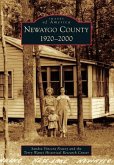Bartlesville was founded in 1897 in the oil-rich northeast corner of a state that was soon to become the most prosperous oil-producing region in the world. Its architectural heritage prior to World War II reflected its citizens' European and East Coast tastes for classical, large-scale buildings typical of the era. Although symbols of their time, as well as the prosperity of their owners, their designs slightly pale in comparison to the unique modernistic styles that began appearing after 1940. Frank Lloyd Wright (1867-1959) and Bruce Goff (1904-1982) were perhaps the most famous architects working in and around Bartlesville in the second half of the century. As harbingers of a new type of "mid-century modernism," their designs were notable alongside those by Hellmuth, Obata and Kassabaum (founded in 1955), Taliesin Associated Architects (founded in 1959), Clifford May (1908-1989), and Thomas McCrory (1925-). Building Bartlesville: 1945-2000 documents the architectural richness of this "City of Legends" and includes photographs, drawings, and documents in an excellent companion for those interested in both Oklahoma history and modern architecture.
Bitte wählen Sie Ihr Anliegen aus.
Rechnungen
Retourenschein anfordern
Bestellstatus
Storno



